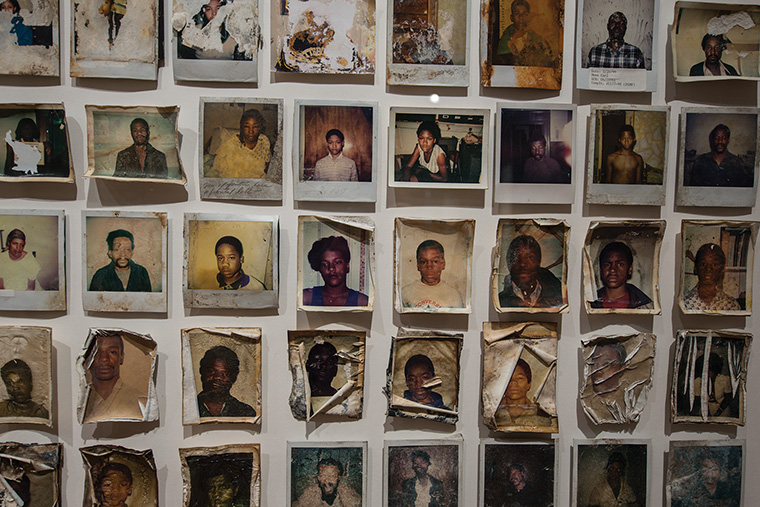Lost photos find controversy.
“Found Photos in Detroit” has come under fire for graphic photographs that include mugshots, photographs of child abuse and homicides.
February 10, 2014
No matter who you are, you have probably taken a selfie. But chances are nobody takes your selfies and uses them in an art exhibit.
Taking pictures of day-to-day routines is a common part of life. Photographing pets, foods and places, then posting them on social media outlets like Twitter, Facebook and Instagram, has become second nature.
Now imagine finding your Twitpics in an art exhibit 30 years from now.
The Museum of Contemporary Photography’s new exhibit, Archive State, features collections of found photographs compiled by artists working from all over the world who aim to use found, also called vernacular, photography to reflect periods of significant socio-economic change.
“I’m sure that the subjects in any of these … found materials, including the YouTube [videos], had the expectation that their photograph, their video would be re-contextualized,” said MoCP Executive Director Natasha Egan.
Running through April 6, the exhibition features the German artist Simon Menner; Thomas Sauvin, a French artist working out of Beijing; Akram Zaatari, founder of the Arab Image Foundation; and David Oresick, who submitted images of American soldiers in Iraq.
The MoCP, housed in the Alexandroff Campus Center, 600 S. Michigan Ave., will hold a public reception for Archive State on Feb. 13.
The most controversial part of the exhibit is the “Found Photos in Detroit” collection, which features photography and documents left in abandoned Detroit homes and
government buildings. Some show explicit content including photos of homicides, child abuse, and private pictures from family albums—raising issues of privacy and ethics.
“[Some of the viewers] were more concerned in ethics, the use of the images and photographs,” said “Found Photo in Detroit” artist and photographer Arianna Arcara. “Another part was more concerned about, is it correct to show this kind of work to make people talk about the problem?”
Italian photojournalists Arcara, 29, and Luca Santese, 28, collected the documents for the Detroit exhibition, which made its U.S. premiere on Jan. 21.
The project received similar reactions in France, Italy and Sweden.
“Found Photos in Detroit” began in August 2009 after Arcara and Santese found Polaroid photographs in a vacant police station in downtown Detroit. The project continued during a second trip in early 2010. The two spent a year narrowing down materials, including handwritten documents, from the roughly 1,300 pieces collected, Arcara said.
“We found the Polaroids first,and we fell in love,” Arcara said. “We thought it was something different, that it was something so powerful, and so we decided to search for it.”
Arcara said she thinks the collection documents the disenfranchised people of Detroit without exploiting them.
“At the end, the problem is that we didn’t take these pictures, so it’s not like I’m deciding what to show,” Arcara said. “We really tried to treat it as an archive. We just showed what we found.”
Senior Film & Video major Mike Miller said he thinks the fact that the photos were found strengthened the work but also raises major ethics questions.
“That’s kind of the beauty of [the photographs]; there’s the anonymous artist aspect,” Miller said. “Then there’s always the question of authorship and is it yours if you find it, or is the artist whoever created it originally?”
The pictures are uncomfortable because no viewer is far removed from the subject matter, Egan said.
During a Jan. 28 panel discussion with both the artists and Columbia faculty from the Photo Department, ethical questions the work raises were addressed.
“In the panel, someone suggested it’s like being in an anthropology museum and that these are studies of objects,” Egan said. “What’s most difficult is they’re very current. This is not looking at something in the distance. It’s sort of looking at our time right now, which is really hard to look at in an anthropological way.”
The artists encourage photo subjects who recognize themselves to contact them. However, nobody has reached out yet, Arcara said.
“In a way, [they would] return back home,” Arcara said. “But actually, me and Luca, we were in Detroit like 10 days ago and a lot of the buildings were torn down [in that time]. All this material would have been lost.”
Miller said he thinks critics of the exhibit do not have legs to stand on.
“I think for them to have a say in it, they’d have to have talked to the subject initially,” Miller said.
Egan thinks “Found Photos in Detroit” is no different in concept than the other artists’ work, but it still carries a unique meaning.
“Are we invading their privacy?” Egan said. “Yes. Is there a difference between a woman in front of her refrigerator in [Sauvin’s] Beijing [work] and the picture of a girl and her birthday cake up in the Detroit work?…but when you add [the fact that] the Detroit work is crime, neglected evidence material, the weight is very different.”








